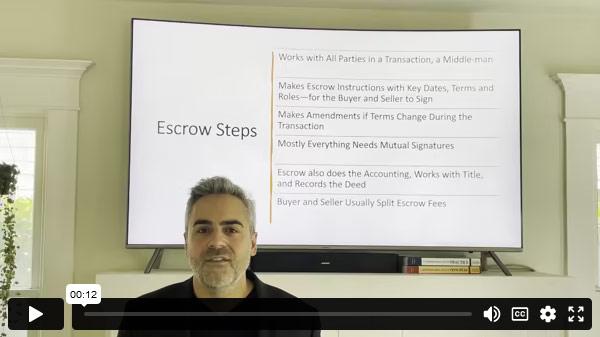The old saying “money makes the world go ‘round” may be true in many ways. Yet, there are good and bad versions of money that can positively or negatively impact us all. On the good side of money, the bulk of an American’s families overall net wealth is likeliest to come from the primary equity in their main owner-occupied home rather than in any other types of investments related to things like stocks, bonds, or commodities.
Once a home is free and clear with no mortgage debt, the entire asset may continue to increase at an annual rate that is much higher than the reported national inflation rate, especially for California properties. In many coastal regions of the state, homes compounded in value 2, 3, 4, 5, or even 10+ times over the course of years or decades. Back in the 1950’s or 1960’s, homes near beaches in prime California locations were selling for as low as $20,000 or $30,000. Over the past several decades, these same once affordable beach area homes are now selling for upwards of a few million dollars or more.
Good Debt – Affordable Mortgage Loans
A property owner who was dedicated enough to pay their 30-year fixed mortgage rate on time each month for 360 months would eventually have a home with no mortgage debt. Or, a property owner who was able to make an extra mortgage payment or two each year might’ve been fortunate to accelerate the payoff of their 30-year loan term down to a much shorter 15 to 20 year term, depending upon how low the interest rate was at the time of the funding of the original mortgage loan. The lower the interest rate on the mortgage loan, the faster the debt will pay off if the homeowner makes extra payments each year.
A mortgage payment has many tax deduction options for the homeowner that may significantly reduce their overall annual tax obligations partly by reducing their net overall taxable income. The fact that the mortgage is tied to the homeowner’s most valuable asset that is likelier to increase in value each year rather than decrease during most years that the property is owned.
There may be some down economic years when the annual rate of return is zero or negative as seen in past years like 2010, 2011, and 2012. However, there will also be some incredibly prosperous boom years in the state when home values are increasing 10%+ each year. Regardless, home values have proven over long periods of time to eventually double, triple, or even quadruple in value for the property owner who is able to hang on and continue to make the mortgage payments up until the property eventually is free and clear with no debt.
Many investors and students have been taught that it’s better to let your money (or asset) work hard for you than for you to work hard for your money. To think in terms of this statement as it relates to real estate is as follows: A free and clear home that consistently appreciates in value will probably create the bulk of the homeowner’ overall financial net worth.
The Rule of 72
The magic of compound growth for various types of investments like real estate or stocks can be simplified using the old Rule of 72 mathematical formula. To summarize this investment rule, a person will divide their projected or forecast annual rate of returns for a potential new investment like a home or technological stock into the number 72 to make a quick estimate regarding how quickly their investment may double in value. As compared with other states, California home prices have consistently increased in value at a higher percentage rate than most other states nationwide.
For example using differing projected annual percentage rate returns that will shorten or lengthen the amount of time that the investment asset may double in value from the original purchase price:
Year Purchased | Purchase Price | Annual Return Projection | Years to Double
2018 | $200,000 | 5% | 14.4
2018 | $400,000 | 7% | 10.2
2018 | $500,000 | 10% | 7.2
For a property that is doubling in value every 10 years, the home will triple in value over the same 30-year time period that it takes to completely pay off a fully amortizing 30-year fixed rate mortgage. Or, that original $400,000 home purchased in 2018 may be worth this amount below over the next 10, 20, and 30 years if it averages more than a 7.2% annual rate of return (72 / 7.2 years = 10 years to double in value) through the various boom and bust housing cycles:
@ 10 years (2028): $800,000
@ 20 years (2038): $1,600,000
@ 30 years (2048): $3,200,000
Real estate is an exceptional hedge against inflation and a weakening dollar. It was quite common for coastal homes in California to appreciate in value a few million dollars over a 30-year span of time just like this example above as hard as it may to believe. Yet, the magic of compound growth as defined by The Rule of 72 helps explain how it can be done.
Bad Debt
All-Time Record High Debt
According to data released by the Federal Reserve in August 2018, all forms of major debt categories for consumers have risen to all-time record highs as noted in the financial categories below:
Total Household Consumer Credit: Almost $4 trillion
Non-Revolving Credit: $2.894 trillion (e.g., student and auto loans)
Student Loan Debt: $1.532 trillion
Automobile Loans: $1.131 trillion
Credit Card Debt: $1.042 trillion
Source: https://www.federalreserve.gov/releases/g19/HIST/cc_hist_sa_levels.html
There is no magic to compounded bad or negative debt associated with student loans, credit cards, automobile loans, or other types of debt that aren’t secured to appreciating assets like real estate. Many of these consumer debts compound and magnify is size at a pace that is 10% to 25%+ each year. If so, the debt just grows in size like a giant snowball heading towards the consumer until he or she is overwhelmed by the size of the massive bad debt.
On the other hand, good debt that is paid off at a relatively fast pace along with the secured asset that is doubling or tripling in value will create wealth and prosperity for the property owner. With the equity growth that a homeowner gains through the ownership of real property or an agent who earns significant real estate commissions in his or her career, the consumer debts can be paid off much sooner until the “bad debt anchor” is disconnected and the “good debt” continues to build newfound wealth for investors, homeowners, and their real estate agents.











